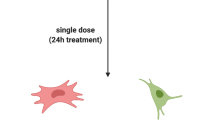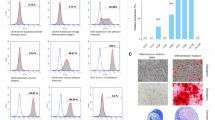Abstract
Purpose
Researchers have actively investigated different treatment strategies to heal bone diseases and injuries. Small molecule–based compounds enhancing osteogenesis have been adapted as one of the promising approaches to treat various bone disorders. Recent studies have been demonstrated several small molecule–based compounds were able to induce long-lasting osteogenic effects (i.e., up to 21 days) following a relatively short 24-h exposure. For instance, previous work from our group revealed that 24-h forskolin exposure induced in vitro osteoblastic differentiation of adipose-derived stem cells (ADSCs) and bone marrow–derived stem cells (BMSCs). However, the molecular link underlying the aforementioned studies has not been described.
Methods
Osteoprogenitor MC3T3-E1 cells were used to study the molecular mechanisms by which the short intervention of forskolin could lead to long-lasting osteogenesis.
Results
We report here the observed effects were associated with upregulation of phosphorylated cAMP-response element binding protein (pCREB) and β-catenin. We also found a number of osteogenic genes were upregulated via PKA-dependent and PKA-independent pathways. We also discovered that the 24-h forskolin treatment scheme could induce osteoprogenitor MC3T3-E1 cells to endogenously produce their own osteogenic and angiogenic growth factors such as insulin-like growth factor 1 (IGF-1) and vascular endothelial growth factor (VEGF).
Conclusion
We propose that an early specific signal mechanism (i.e., cAMP signaling in this study) is important for triggering a bone-regenerating program. In addition, the small molecule forskolin may be capable of inducing cell differentiation towards osteogenic lineage utilizing growth factor–based inductive paracrine and autocrine loops. Thus, these two mechanisms may contribute to the aforementioned observation of the short-term forskolin–mediated bone regeneration.
Lay Summary
Small molecule–based therapeutics have emerged as an alternative to traditional growth factor treatments such as recombinant human bone morphogenetic proteins (rhBMPs). In order to reduce the side effects of these treatments, researchers have evaluated approaches focusing on reducing the dosage and frequency of administration. This study describes the underlying behavior of this small molecule treatment approach in promoting bone formation within cells.
Future Work
Future studies will focus on investigating the instructive set of signals (e.g., using RNA-seq or DNA micro-array) that specifically trigger of MSCs upon short-term treatment of forskolin.





Similar content being viewed by others
References
Einhorn TA, Gerstenfeld LC. Fracture healing: mechanisms and interventions. Nat Rev Rheumatol. 2015;11(1):45–54. https://doi.org/10.1038/nrrheum.2014.164.
Marsell R, Einhorn TA. The biology of fracture healing. Injury. 2011;42(6):551–5. https://doi.org/10.1016/j.injury.2011.03.031.
Bayer EA, Gottardi R, Fedorchak MV, Little SR. The scope and sequence of growth factor delivery for vascularized bone tissue regeneration. J Control Release. 2015;219:129–40. https://doi.org/10.1016/j.jconrel.2015.08.004.
Lissenberg-Thunnissen SN, de Gorter DJJ, Sier CFM, Schipper IB. Use and efficacy of bone morphogenetic proteins in fracture healing. Int Orthop (SICOT). 2011;35(9):1271. https://doi.org/10.1007/s00264-011-1301-z.
James AW, et al. A review of the clinical side effects of bone morphogenetic protein-2. Tissue Eng Part B Rev. 2016;22(4):284–97. https://doi.org/10.1089/ten.teb.2015.0357.
Lo KW-H, Jiang T, Gagnon KA, Nelson C, Laurencin CT. Small-molecule based musculoskeletal regenerative engineering. Trends Biotechnol. 2014;32(2):74–81. https://doi.org/10.1016/j.tibtech.2013.12.002.
Aravamudhan A, et al. Osteoinductive small molecules: growth factor alternatives for bone tissue engineering. CPD. 2013;19(19):3420–8. https://doi.org/10.2174/1381612811319190008.
Carbone EJ, Rajpura K, Jiang T, Laurencin CT, Lo KW-H. Regulation of bone regeneration with approved small molecule compounds. Adv Regen Biology. 2014;1(1):25276. https://doi.org/10.3402/arb.v1.25276.
Laurencin CT, Ashe KM, Henry N, Kan HM, Lo KW-H. Delivery of small molecules for bone regenerative engineering: preclinical studies and potential clinical applications. Drug Discov Today. 2014;19(6):794–800. https://doi.org/10.1016/j.drudis.2014.01.012.
Lo KW-H, Ashe KM, Kan HM, Laurencin CT. The role of small molecules in musculoskeletal regeneration. Regen Med. 2012;7(4):535–49. https://doi.org/10.2217/rme.12.33.
Lo KW-H. Effects on bone regeneration of single-dose treatment with osteogenic small molecules. Drug Discov Today. 2022;27(6):1538–44. https://doi.org/10.1016/j.drudis.2022.02.020.
Murugan NJ, et al. “Acute multidrug delivery via a wearable bioreactor facilitates long-term limb regeneration and functional recovery in adult Xenopus laevis,.” Sci Adv. 2022;8(4):eabj2164. https://doi.org/10.1126/sciadv.abj2164.
Ifegwu OC, Awale G, Rajpura K, Lo KW-H, Laurencin CT. Harnessing cAMP signaling in musculoskeletal regenerative engineering. Drug Discov Today. 2017;22(7):1027–44. https://doi.org/10.1016/j.drudis.2017.03.008.
Epstein PM. “Bone and the cAMP signaling pathway: emerging therapeutics,” in Bone-Metabolic Functions and Modulators, F. Bronner, M. C. Farach-Carson, and H. I. Roach, Eds. London: Springer London. 2012. pp. 271–287. https://doi.org/10.1007/978-1-4471-2745-1_16.
Doorn J, Siddappa R, van Blitterswijk CA, de Boer J. Forskolin enhances in vivo bone formation by human mesenchymal stromal cells. Tissue Eng Part A. 2012;18(5–6):558–67. https://doi.org/10.1089/ten.tea.2011.0312.
Ifegwu OC, et al. Bone regenerative engineering using a protein kinase A-specific cyclic AMP analogue administered for short term. Regen Eng Transl Med. 2018;4(4):206–15. https://doi.org/10.1007/s40883-018-0063-1.
Lo KW-H, Ulery BD, Kan HM, Ashe KM, Laurencin CT. Evaluating the feasibility of utilizing the small molecule phenamil as a novel biofactor for bone regenerative engineering: small molecule phenamil for bone regenerative engineering. J Tissue Eng Regen Med. 2014;8(9):728–36. https://doi.org/10.1002/term.1573.
Lo KW-H, Kan HM, Gagnon KA, Laurencin CT. One-day treatment of small molecule 8-bromo-cyclic AMP analogue induces cell-based VEGF production for in vitro angiogenesis and osteoblastic differentiation. J Tissue Eng Regen Med. 2016;10(10):867–75. https://doi.org/10.1002/term.1839.
Awale G, Barajaa M, Kan HM, Lo K W-H, Laurencin CT. “Single-dose induction of osteogenic differentiation of mesenchymal stem cells using a cyclic AMP activator, forskolin,” Regen Eng Transl Med. vol. In press, 2022.
Alasbahi RH, Melzig MF. Forskolin and derivatives as tools for studying the role of cAMP. Die Pharm - Int J Pharm Sci. 2012;67(1):5–13. https://doi.org/10.1691/ph.2012.1642.
Alasbahi RH, Melzig MF. Plectranthus barbatus: a review of phytochemistry, ethnobotanical uses and pharmacology — part 2. Planta Med. 2010;76(8):753–65. https://doi.org/10.1055/s-0029-1240919.
Sapio L, et al. The natural cAMP elevating compound forskolin in cancer therapy: is it time? J Cell Physiol. 2017;232(5):922–7. https://doi.org/10.1002/jcp.25650.
Lo KW-H, Kan H-M, Pfister KK. Identification of a novel region of the cytoplasmic Dynein intermediate chain important for dimerization in the absence of the light chains. J Biol Chem. 2006;281(14):9552–9. https://doi.org/10.1074/jbc.M511721200.
Murray AJ. “Pharmacological PKA inhibition: all may not be what it seems,.” Sci Signal. 2008;1(22):re4–re4. https://doi.org/10.1126/scisignal.122re4.
Choi M-H, Noh W-C, Park J-W, Lee J-M, Suh J-Y. Gene expression pattern during osteogenic differentiation of human periodontal ligament cells in vitro. J Periodontal Implant Sci. 2011;41(4):167–75. https://doi.org/10.5051/jpis.2011.41.4.167.
Xu J, Li Z, Hou Y, Fang W. Potential mechanisms underlying the runx2 induced osteogenesis of bone marrow mesenchymal stem cells. Am J Transl Res. 2015;7(12):2527–35.
Kannan S, Ghosh J, Dhara SK. “Osteogenic differentiation potential of porcine bone marrow mesenchymal stem cell subpopulations selected in different basal media,.” Biol Open. 2020;9(10):bio053280. https://doi.org/10.1242/bio.053280.
Si J, Wang C, Zhang D, Wang B, Hou W, Zhou Y. “Osteopontin in bone metabolism and bone diseases,” Med Sci Monit. 2020;26. pp. e919159–1-e919159–9. https://doi.org/10.12659/MSM.919159.
Namkoong S, et al. Forskolin increases angiogenesis through the coordinated cross-talk of PKA-dependent VEGF expression and Epac-mediated PI3K/Akt/eNOS signaling. Cell Signal. 2009;21(6):906–15. https://doi.org/10.1016/j.cellsig.2009.01.038.
Esen E, Lee S-Y, Wice BM, Long F. PTH-IGF signaling promotes bone formation through glycolysis. J Bone Miner Res. 2015;30(11):1959–68. https://doi.org/10.1002/jbmr.2556.
O’Neill E, Rajpura K, Carbone EJ, Awale G, Kan H-M, Lo KW-H. Repositioning tacrolimus: evaluation of the effect of short-term tacrolimus treatment on osteoprogenitor cells and primary cells for bone regenerative engineering. Assay Drug Dev Technol. 2019;17(2):77–88. https://doi.org/10.1089/adt.2018.876.
Lo KW-H, Kan HM, Laurencin CT. Short-term administration of small molecule phenamil induced a protracted osteogenic effect on osteoblast-like MC3T3-E1 cells: short phenamil treatment induces osteoblastic differentiation. J Tissue Eng Regen Med. 2016;10(6):518–26. https://doi.org/10.1002/term.1786.
Balmayor ER. Targeted delivery as key for the success of small osteoinductive molecules. Adv Drug Deliv Rev. 2015;94:13–27. https://doi.org/10.1016/j.addr.2015.04.022.
Goonoo N, Bhaw-Luximon A. Mimicking growth factors: role of small molecule scaffold additives in promoting tissue regeneration and repair. RSC Adv. 2019;9(32):18124–46. https://doi.org/10.1039/C9RA02765C.
Lo KW-H, Kan HM, Ashe KM, Laurencin CT. The small molecule PKA-specific cyclic AMP analogue as an inducer of osteoblast-like cells differentiation and mineralization. J Tissue Eng Regen Med. 2012;6(1):40–8. https://doi.org/10.1002/term.395.
Zhang Z-R, et al. “Osthole enhances osteogenesis in osteoblasts by elevating transcription factor osterix via cAMP/CREB signaling in vitro and in vivo,” Nutrients. 2017;9(6):Art. no. 6. https://doi.org/10.3390/nu9060588.
Delghandi MP, Johannessen M, Moens U. The cAMP signalling pathway activates CREB through PKA, p38 and MSK1 in NIH 3T3 cells. Cell Signal. 2005;17(11):1343–51. https://doi.org/10.1016/j.cellsig.2005.02.003.
Park KH, Choi Y, Yoon DS, Lee K-M, Kim D, Lee JW. Zinc promotes osteoblast differentiation in human mesenchymal stem cells via activation of the cAMP-PKA-CREB signaling pathway. Stem Cells Dev. 2018;27(16):1125–35. https://doi.org/10.1089/scd.2018.0023.
Kim J-M, et al. An activator of the cAMP/PKA/CREB pathway promotes osteogenesis from human mesenchymal stem cells. J Cell Physiol. 2013;228(3):617–26. https://doi.org/10.1002/jcp.24171.
Ho WC, Greene RM, Shanfeld J, Davidovitch Z. Cyclic nucleotides during chondrogenesis: concentration and distribution in vivo and in vitro. J Exp Zool. 1982;224(3):321–30. https://doi.org/10.1002/jez.1402240305.
Solursh M, Reiter R, Ahrens PB, Pratt RM. Increase in levels of cyclic AMP during avian limb chondrogenesis in vitro. Differentiation. 1979;15(1):183–6. https://doi.org/10.1111/j.1432-0436.1979.tb01049.x.
Kim MO, Lee YJ, Park JH, Ryu JM, Yun SP, Han HJ. PKA and cAMP stimulate proliferation of mouse embryonic stem cells by elevating GLUT1 expression mediated by the NF-κB and CREB/CBP signaling pathways. Biochim Biophys Acta. 2012;1820(10):1636–46. https://doi.org/10.1016/j.bbagen.2012.05.008.
Oryan A, Kamali A, Moshiri A, Eslaminejad MB. Role of mesenchymal stem cells in bone regenerative medicine: what is the evidence? CTO. 2017;204(2):59–83. https://doi.org/10.1159/000469704.
Ikegame M, Ejiri S, Okamura H. Expression of non-collagenous bone matrix proteins in osteoblasts stimulated by mechanical stretching in the cranial suture of neonatal mice. J Histochem Cytochem. 2019;67(2):107–16. https://doi.org/10.1369/0022155418793588.
Ferretti C, et al. Role of IGF1 and IGF1/VEGF on human mesenchymal stromal cells in bone healing: two sources and two fates. Tissue Eng Part A. 2014;20(17–18):2473–82. https://doi.org/10.1089/ten.tea.2013.0453.
Dicarlo M, Bianchi N, Ferretti C, Orciani M, Primio RD, Mattioli-Belmonte M. Evidence supporting a paracrine effect of IGF-1/VEGF on human mesenchymal stromal cell commitment. CTO. 2016;201(5):333–41. https://doi.org/10.1159/000445346.
Cheng Y-H, Dong J-C, Bian Q. Small molecules for mesenchymal stem cell fate determination. World J Stem Cells. 2019;11(12):1084–103. https://doi.org/10.4252/wjsc.v11.i12.1084.
Knight MN, Hankenson KD. Mesenchymal stem cells in bone regeneration. Adv Wound Care (New Rochelle). 2013;2(6):306–16. https://doi.org/10.1089/wound.2012.0420.
Cushnie EK, et al. Simple signaling molecules for inductive bone regenerative engineering. PLoS ONE. 2014;9(7):e101627. https://doi.org/10.1371/journal.pone.0101627.
Funding
The work was supported by funding from the NIH Director’s Pioneer Award DP1-AR-068147 and NIH T32 AR079114. G.M.A. was supported by the NIH Supplemental Grant to Promote Diversity in Health-Related Research Program (NIH Grant 5R21EB024787-03) and NSF-EFRI-REM (#1332329).
Author information
Authors and Affiliations
Corresponding author
Ethics declarations
Conflict of Interests
Dr. Cato T. Laurencin is the editor-in-chief and Dr. Kevin Lo is the assistant managing editor of Regenerative Engineering and Translational Medicine. Dr. Cato T. Laurencin has the following competing financial interests: Mimedx, Alkermes Company, Biobind, Soft Tissue Regeneration/Biorez, and Healing Orthopaedic Technologies-Bone. The authors have no non-financial competing interests.
Additional information
Publisher's Note
Springer Nature remains neutral with regard to jurisdictional claims in published maps and institutional affiliations.
Rights and permissions
Springer Nature or its licensor (e.g. a society or other partner) holds exclusive rights to this article under a publishing agreement with the author(s) or other rightsholder(s); author self-archiving of the accepted manuscript version of this article is solely governed by the terms of such publishing agreement and applicable law.
About this article
Cite this article
Awale, G., Kan, HM., Laurencin, C.T. et al. Molecular Mechanisms Underlying the Short-Term Intervention of Forskolin-Mediated Bone Regeneration. Regen. Eng. Transl. Med. 9, 375–383 (2023). https://doi.org/10.1007/s40883-022-00285-8
Received:
Revised:
Accepted:
Published:
Issue Date:
DOI: https://doi.org/10.1007/s40883-022-00285-8




